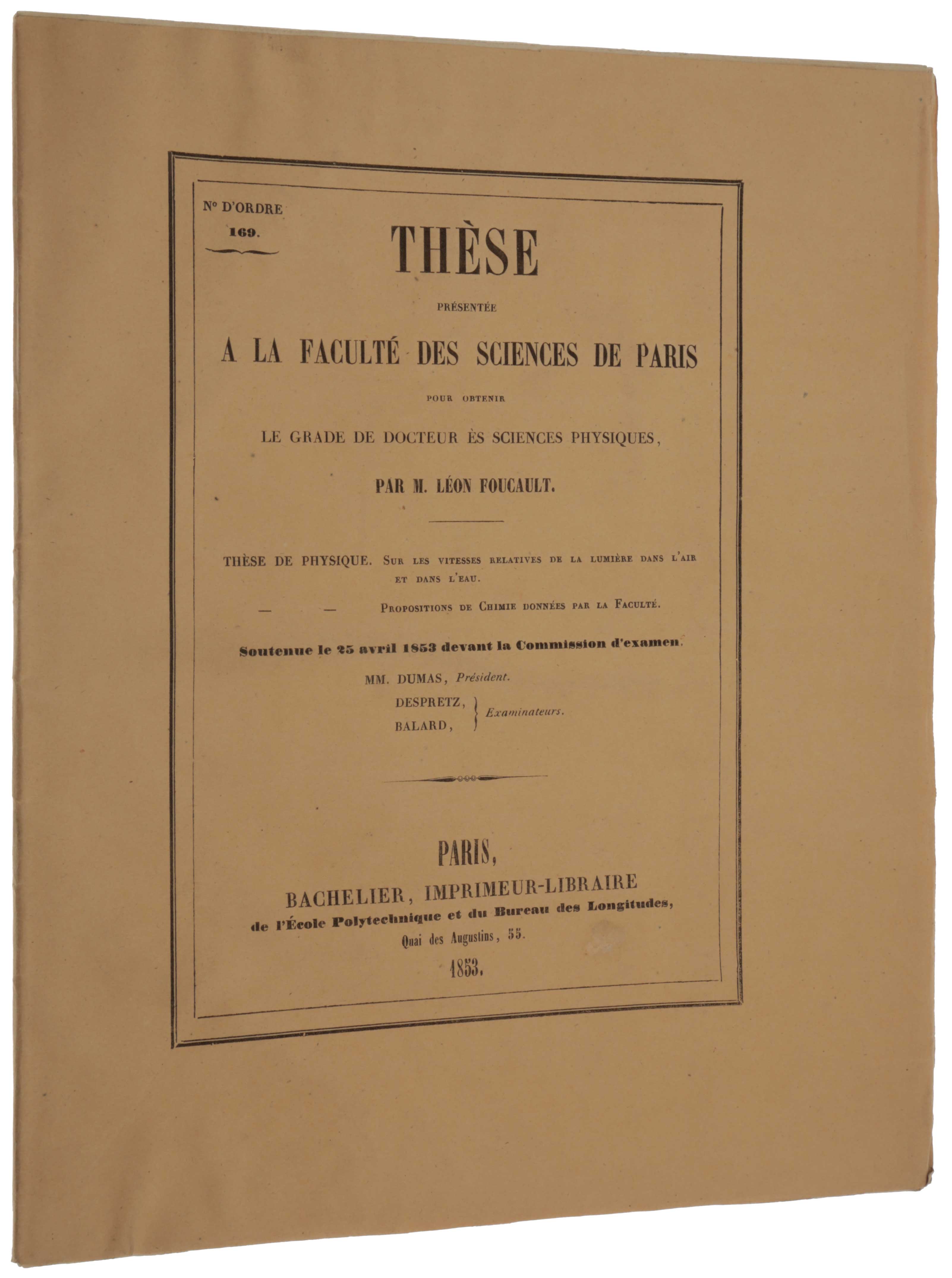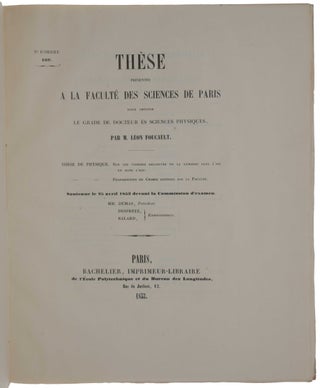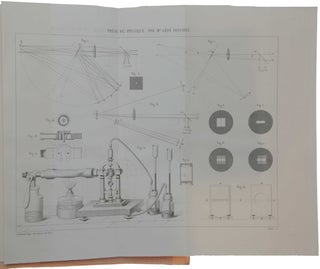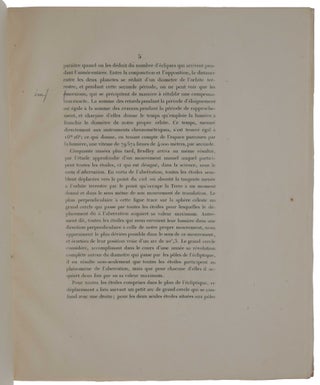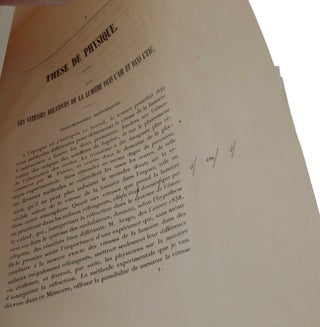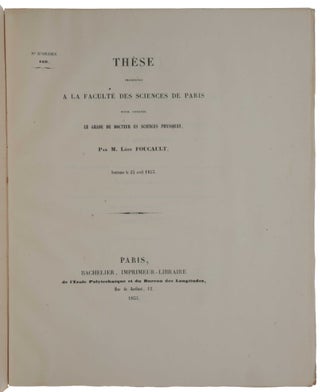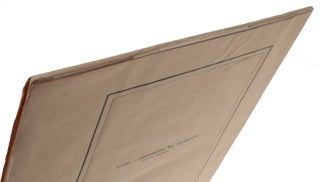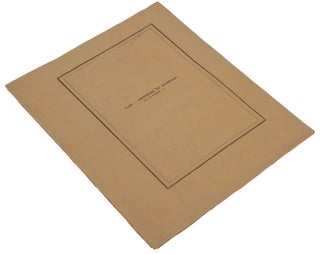Thèse présentée à la faculté des sciences de Paris... Sur les vitesses rélatives de la lumière dans l’air et dans l’eau.
Paris: Bachelier, 1853. First edition, rare, and an exceptionally fine copy, of Foucault’s doctoral thesis on the speed of light, in which he provides a convincing proof for the wave theory of light. In the 1840s Foucault undertook a series of optical experiments using an apparatus of rotating mirrors to determine the velocity of light. Originally developed by Charles Wheatstone to measure the velocity of electricity, the rotating mirror apparatus had been proposed as an instrument for the measurement of light in 1838 by Dominique-François Arago who failed in his own attempts to carry out the experiment. Foucault’s initial work was carried out in conjunction with the physicist Armand Hippolyte Louis Fizeau (1819-1896); but a personal dispute broke up their partnership in 1847 and the two collaborators became rivals, working separately on the same problem using the same technique. Both reached the same conclusion, but while Fizeau was the first to obtain, in 1849, a precision measurement of the velocity of light, Foucault pre-empted him in announcing, on 30 April 1850, that light travels faster in air than in water, a decisive argument in favour of the wave theory of light, which by the mid-nineteenth century had become generally accepted. In his thesis Foucault gives a detailed account of his experiment, illustrating his apparatus; it was not until 1862 that he was able to determine a numerical value for the speed of light, of about 298,000 kilometers per second, a figure significantly smaller, and more accurate, than Fizeau’s. Foucault is today best known for the pendulum experiments demonstrating the rotation of the earth which he performed in 1851. Perhaps he considered these experiments to be unsuitable as a thesis topic as the result (the rotation of the earth) was well known to everyone, whereas the results of his air-and-water experiments, though expected by most scientists, were new. ABPC/RBH list five copies in the last 40 years: Christie’s 2008, $17,395; Christie’s, Paris 2004, €9000; Christie’s 2004, $8,812; Christie’s 1999, $10,350; Christie’s 1998, $7,475. “The early-to-mid 1800s were a period of intense debate on the particle-versus-wave nature of light. Although the observation of the Arago spot in 1819 may seem to have settled the matter definitively in favor of Fresnel’s wave theory of light, various concerns continued to appear to be addressed more satisfactorily by Newton’s corpuscular theory … “In 1834, Charles Wheatstone developed a method of using a rapidly rotating mirror to study transient phenomena, and applied this method to measure the velocity of electricity in a wire and the duration of an electric spark [‘An Account of Some Experiments to Measure the Velocity of Electricity and the Duration of Electric Light,’ Philosophical Transactions of the Royal Society of London, vol. 124, pp. 583–591]. He communicated to François Arago the idea that his method could be adapted to a study of the speed of light. Arago expanded upon Wheatstone’s concept in an 1838 publication [‘Sur un système d'expériences à l'aide duquel la théorie de l'émission et celle des ondes seront soumises à des épreuves décisives,’ Comptes rendus hebdomadaires des séances de l'Académie des sciences, vol. 7, pp. 954-960], emphasizing the possibility that a test of the relative speed of light in air versus water could be used to distinguish between the particle and wave theories of light” (Wikipedia). “A comparison of this velocity in air and in water would be a clear experimental test between the wave and particle theories of light, since the former required light to travel faster in air; the latter, in water” (DSB). “In 1845, Arago suggested to Fizeau and Foucault that they attempt to measure the speed of light. Sometime in 1849, however, it appears that the two had a falling out, and they parted ways pursuing separate means of performing this experiment. In 1848-49, Fizeau used, not a rotating mirror, but a toothed wheel apparatus to perform an absolute measurement of the speed of light in air … “In 1850 and in 1862, Léon Foucault made improved determinations of the speed of light substituting a rotating mirror for Fizeau's toothed wheel. The apparatus involves light from a slit S reflecting off a rotating mirror R, forming an image of the slit on the distant stationary mirror M, which is then reflected back to reform an image of the original slit. If mirror R is stationary, then the slit image will reform at S regardless of the mirror's tilt. The situation is different, however, if R is in rapid rotation. As the rotating mirror R will have moved slightly in the time it takes for the light to bounce from R to M and back, the light will be deflected away from the original source by a small angle. “Guided by similar motivations as his former partner, Foucault in 1850 was more interested in settling the particle-versus-wave debate than in determining an accurate absolute value for the speed of light. Foucault measured the differential speed of light through air versus water by inserting a tube filled with water between the rotating mirror and the distant mirror. His experimental results, announced shortly before Fizeau announced his results on the same topic, were viewed as ‘driving the last nail in the coffin’ of Newton’s corpuscle theory of light when it showed that light travels more slowly through water than through air. Newton had explained refraction as a pull of the medium upon the light, implying an increased speed of light in the medium. The corpuscular theory of light went into abeyance, completely overshadowed by wave theory. This state of affairs lasted until 1905, when Einstein presented heuristic arguments that under various circumstances, such as when considering the photoelectric effect, light exhibits behaviors indicative of a particle nature. “In contrast to his 1850 measurement, Foucault’s 1862 measurement was aimed at obtaining an accurate absolute value for the speed of light, since his concern was to deduce an improved value for the astronomical unit. At the time, Foucault was working at the Paris Observatory under Urbain le Verrier. It was le Verrier’s belief, based on extensive celestial mechanics calculations, that the consensus value for the speed of light was perhaps 4% too high. Technical limitations prevented Foucault from separating mirrors R and M by more than about 20 meters. Despite this limited path length, Foucault was able to measure the displacement of the slit image (less than 1 mm) with considerable accuracy. In addition, unlike the case with Fizeau’s experiment (which required gauging the rotation rate of an adjustable-speed toothed wheel), he could spin the mirror at a constant, chronometrically determined speed. Foucault’s measurement confirmed le Verrier’s estimate. His 1862 figure for the speed of light (298000 km/s) was within 0.6% of the modern value” (Wikipedia). Jean Bernard Léon Foucault (1819-68) “worked in a laboratory set up in his home until, following the award of the Cross of the Legion of Honor in 1851 (for his pendulum experiment) and the docteur ès sciences physiques in 1853 (for his thesis comparing the velocity of light in air and water), he was given a place as physicist at the Paris observatory by Napoleon III. Further honors followed: the Copley Medal of the Royal Society in 1855, officer of the Legion of Honor and member of the Bureau des Longitudes in 1862, and foreign member of the Royal Society (1864) and the academies of Berlin and St. Petersburg. Finally, after having failed to be elected in 1857, Foucault was chosen in 1865, following the death of Clapeyron, a member of the Académie des Sciences” (DSB). En français dans le texte 270; Norman 820.
4to (282 x 230 mm), pp. [iv], 35, [1], with one large folding engraved plate. Original printed wrappers, unopened. Marginal corrections to text on pages 3 and 5 (in the author’s hand?). Very rare in such fine condition.
Item #4843
Price: $28,500.00

